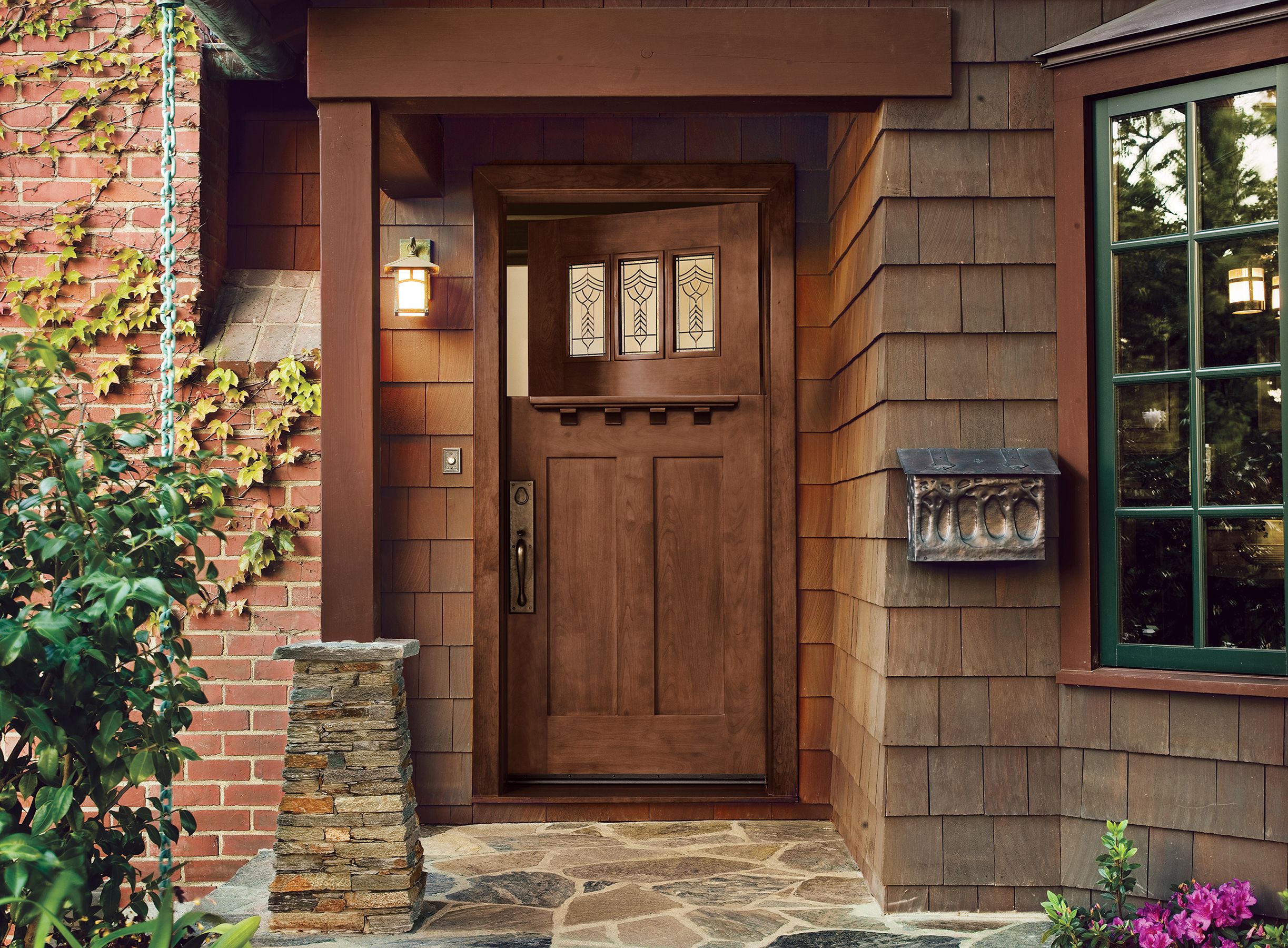Fiberglass doors are low-maintenance, durable, and energy-efficient. They come in many styles and designs, making them popular among homeowners. If you’re in the market for a new entryway door and are considering your options, we can help. In this guide, we’ll tell you all about fiberglass doors, how to install them, and what to look for when deciding which door is right for your home.
What Are Fiberglass Entry Doors?
Fiberglass entry doors are composite doors made from glass fiber-reinforced polymers, similar to materials used in aircraft and high-performance vehicles. They consist of a foam core sandwiched between fiberglass skins and are often reinforced with wood or composite frames.
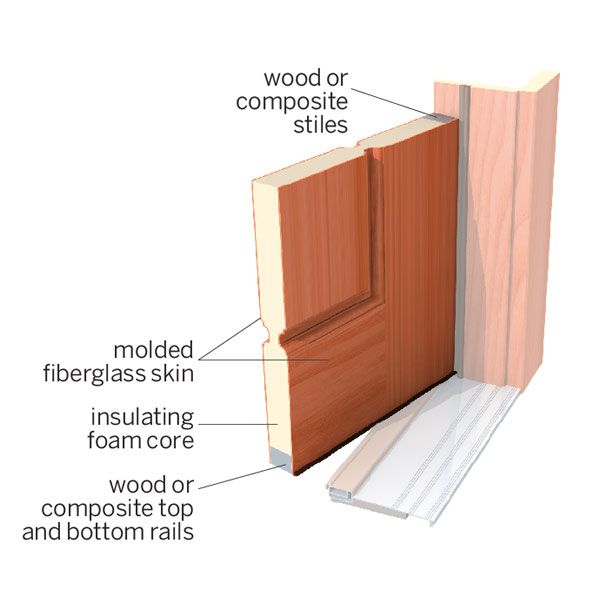
Fiberglass doors have transformed since they first appeared on the market. Today, they’re more modern and aesthetically pleasing. As Tim Ellenz, president of California Window and Door, notes, “Manufacturers have given the skins real life now.” They’ve reinvented fiberglass doors by making them mimic the look and texture of various wood grains.
Similar to shown: Aurora Custom Fiberglass Collection, prehung and factory-finished door with hardware; jeld-wen.com
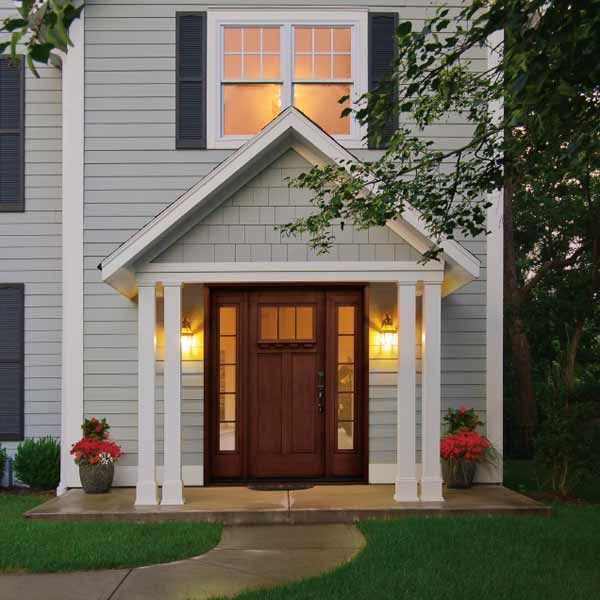
Advantages of Fiberglass Entry Doors
Fiberglass doors are increasingly popular because of the many advantages they offer to homeowners. We’ll cover some of those benefits below:
Aesthetic Versatility
There are fiberglass door designs to suit most architectural styles. From traditional wood-grain textures that mimic mahogany, oak, or fir to smooth, contemporary finishes, you’ll find something that fits your specific taste and home decor.
Manufacturers offer doors with numerous panel designs, glass options, and hardware choices. If you can’t find what you’re looking for, some manufacturers can customize your door to fit your preferences.
Durability and Weather Resistance
Fiberglass doors are more durable than other door types. They don’t warp, rot, shrink, or swell due to temperature or humidity changes like wood doors often do. Your door will maintain its shape year-round, allowing you to avoid drafts in the winter.
Fiberglass doors resist insects and fire, so your home has an extra layer of protection. They can also withstand harsh weather conditions, including intense sun exposure and heavy rains.
Energy Efficiency
A fiberglass entry door’s foam core is better equipped to prevent heat from traveling through it than wood doors. This enhanced insulation helps maintain indoor temperatures in your home, which can lead to reduced heating and cooling bills. However, doors with windows can impact energy efficiency, leading many manufacturers to offer low-emissivity (low-e) glass coatings that improve the door’s insulation.
Low-Maintenance
Fiberglass doors don’t require a lot of upkeep—unlike wood doors, which you need to paint regularly to protect against the elements. Per This Old House general contractor Tom Silva, regular cleaning with a damp cloth is the only routine upkeep necessary.
A fiberglass door’s finish is durable and resists much of the chipping and peeling other door types experience. You can apply clear marine varnish or paint if you notice fading from harsh sunlight, but fiberglass is otherwise low-maintenance.
Similar to shown: Molded fiberglass panels and simulated divided lights can capture the look of wood French doors. Prehung and factory-finished European three-quarters lite double door, 96 inches tall; pella.com
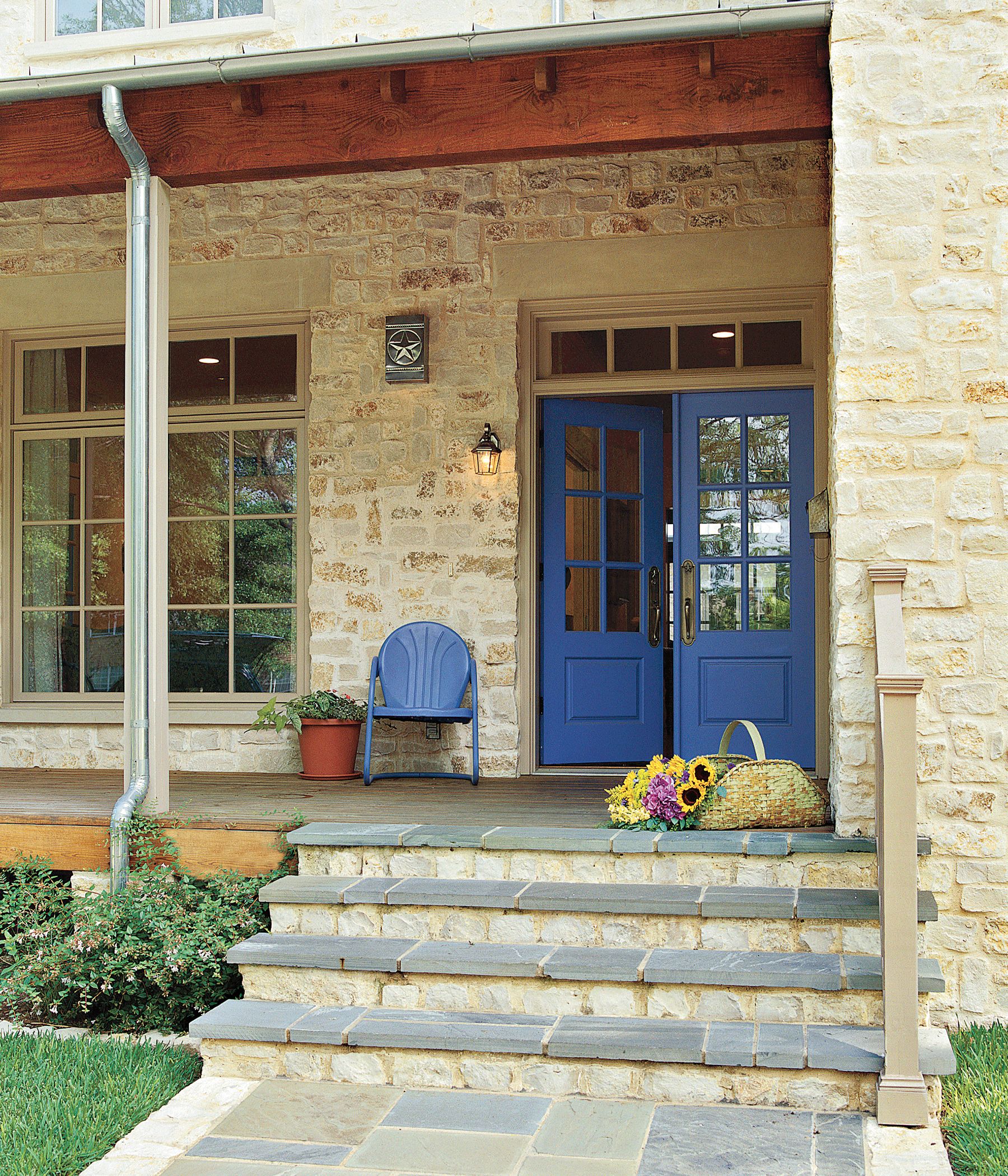
Potential Drawbacks of Fiberglass Front Doors
Fiberglass doors also have disadvantages, including higher upfront costs and susceptibility to cracking. Learn more about their limitations below before deciding on a fiberglass door for your home:
Initial Cost Considerations
Fiberglass doors run between $150 and $3,000, making them more expensive than wood and steel doors. Although fiberglass doors require a higher initial investment than some other door types, they are durable and low-maintenance, which can make up for the higher price you pay.
*Prices in this section sourced from Angi
Limited Customization Options
You can customize your fiberglass door, but your options are still limited. It might be difficult for homeowners to find unique molds unless they’re willing to pay higher prices. You also may find it hard to find a fiberglass door that fits a nonstandard door opening. However, for most homeowners, the variety of styles and options available in fiberglass doors is sufficient to find a suitable match for their home’s architecture and personal taste.
Potential for Cracking
Fiberglass doors can withstand a lot, but the skin can crack from hard impact, such as a stray golf ball. The skin may also peel away from the frame, but this is more likely if the door has wood stiles or the manufacturer didn’t properly seal the rails.
However, these issues are relatively rare and you can often repair the damage. As Silva suggests, “If the fiberglass skin cracks, you can use Bondo to fill the gap. While the filler is still soft, use a sharp pencil to mimic the door’s graining. Sand the hardened patch lightly and refinish the entire door.”
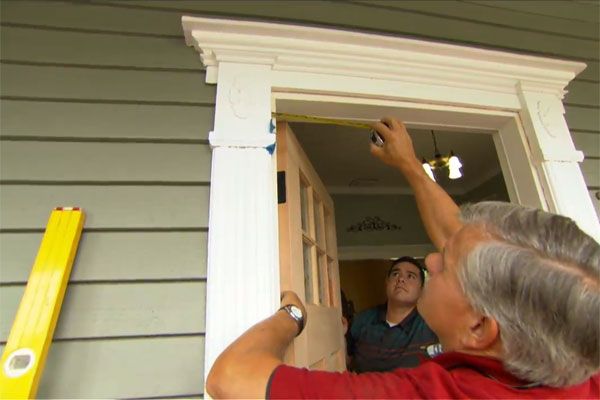
Fiberglass vs. Other Entry Door Materials
Before you decide whether to purchase a fiberglass door, compare it to other common doors first. Let’s see how fiberglass stacks up against wood and steel doors.
Fiberglass vs. Wood Doors
Homeowners appreciate wood doors for their natural beauty, warmth, and authenticity. You can easily plane them if your house settles, and many come with laminated veneers and engineered lumber cores to help with swelling and sticking. However, they require more routine maintenance than fiberglass because they are vulnerable to the sun and rain.
Fiberglass doors aren’t as prone to damage and can mimic wood grain. They’re more energy-efficient, which may result in lower energy bills, but they are more expensive upfront than wood doors.
Fiberglass vs. Steel Doors
Steel doors are affordable and offer security and energy efficiency. They’re very popular and you can easily find one with a high fire rating. However, steel doors don’t look like high-quality wood grain the way fiberglass doors do, and they’re susceptible to denting. They’re also prone to rust and can be hot or cold to touch. Fiberglass doors don’t rust and maintain a more consistent temperature.
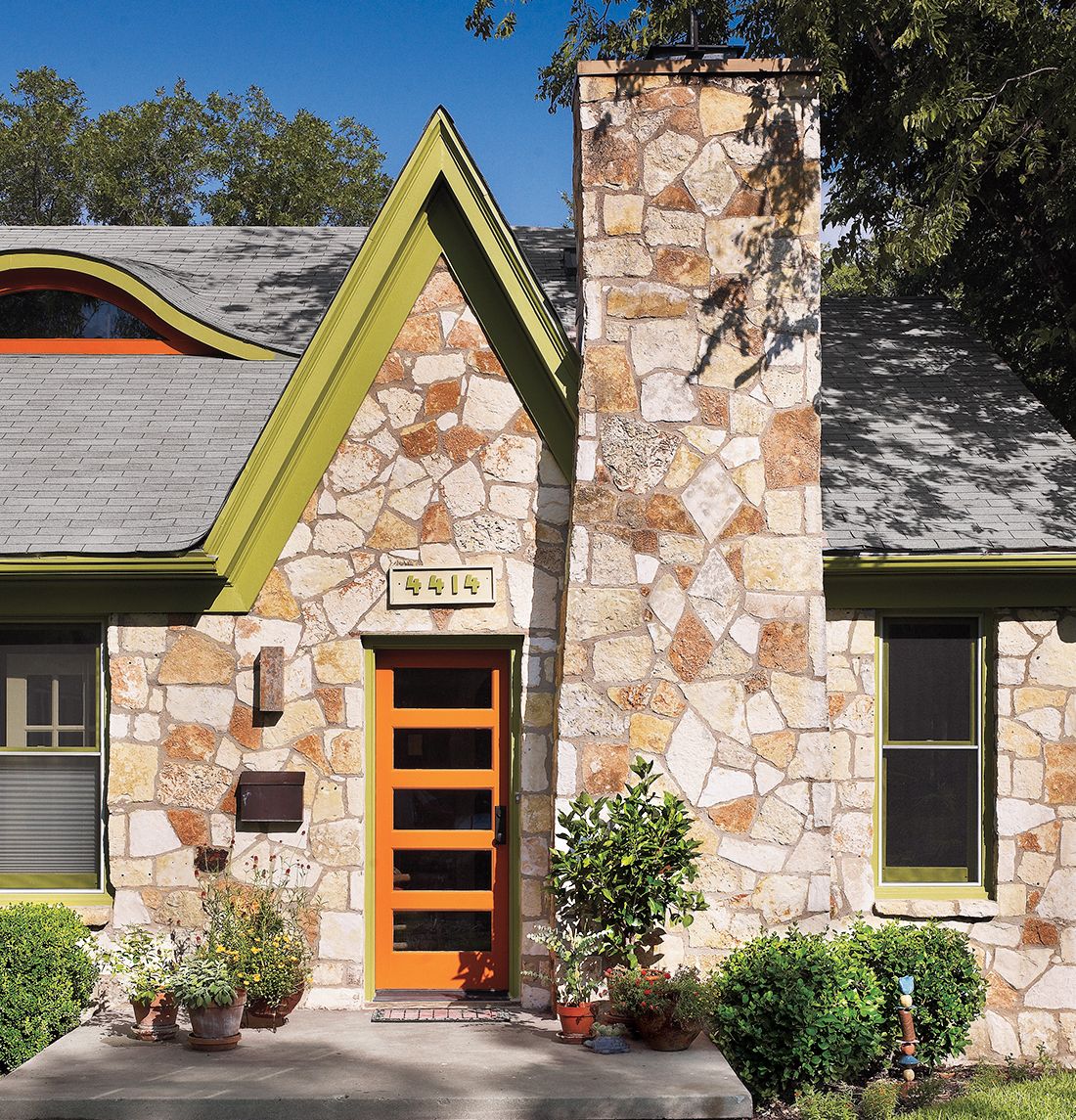
Styles and Designs of Fiberglass Entry Doors
If you move forward with a fiberglass door, you’ll have many different designs to choose from. We’ll cover some of those styles below:
Contemporary Designs
A homeowner interested in a sleeker look may opt for a contemporary design, which can include the following:
- Flush doors: They have smooth, flat surfaces without panels or embellishments for a streamlined appearance.
- Geometric patterns: You can find bold geometric designs within the door’s structure or glass to give your entryway a modern feel with visual interest.
- Large glass panels: If you’re looking for a door that brings in natural light, you can find fiberglass doors with expansive glass areas. These doors have low-e glass so they’re still energy-efficient.
Craftsman-Inspired Options
Craftsman-style doors are another fiberglass option. Some of their accents include the following:
- Decorative glass: You can find doors with stained glass or simple geometric patterns.
- Distinctive window configurations: These doors may have a distinctive shelf below a rectangular window in the upper third of the door and they’re sometimes divided into multiple panes.
- Textured wood grain: Some doors have a pronounced wood grain texture that mimics quartersawn oak or other traditional Craftsman woods.
Traditional Styles
Traditional fiberglass door styles resemble classic wood door designs, including the following:
- Colonial: These doors have raised panels. They look like wood, but they won’t experience panel separation.
- Victorian: These fiberglass doors showcase tall, arched windows with wood-grain patterns. They may also have decorative glass with intricate designs.
Examples
To get a better idea of the most popular fiberglass door designs on the market, take a look at the images below:
Colonial Style
Molded raised panels suggest the look of wood, but since fiberglass won’t expand or contract, they won’t need recalling.
Similar to shown: six-panel slab door with wood-grain-texture fiberglass skin and factory-applied paint; plastproinc.com
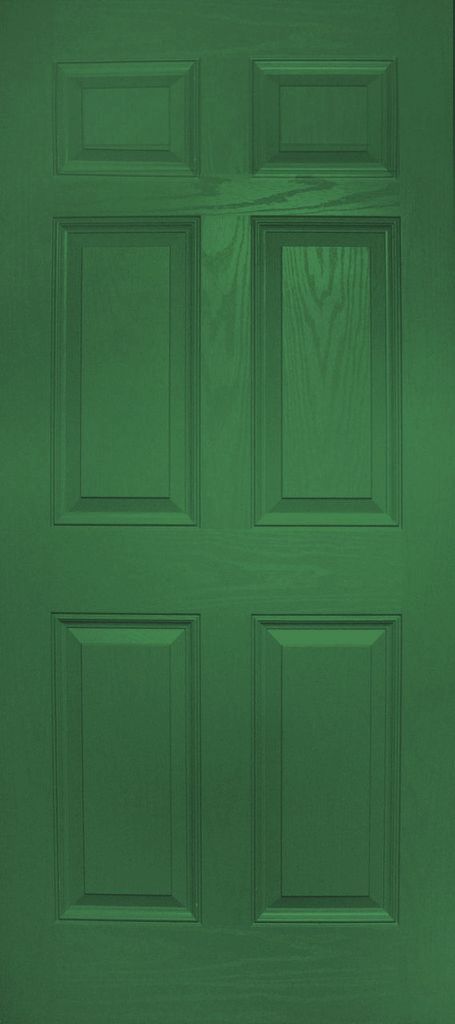
Contemporary Style
Crisp geometric lines give this smooth-skinned door a clean, modern look.
Similar to shown: Ari door with low-e glass from the Pulse collection, prehung and paint-ready; thermatru.com
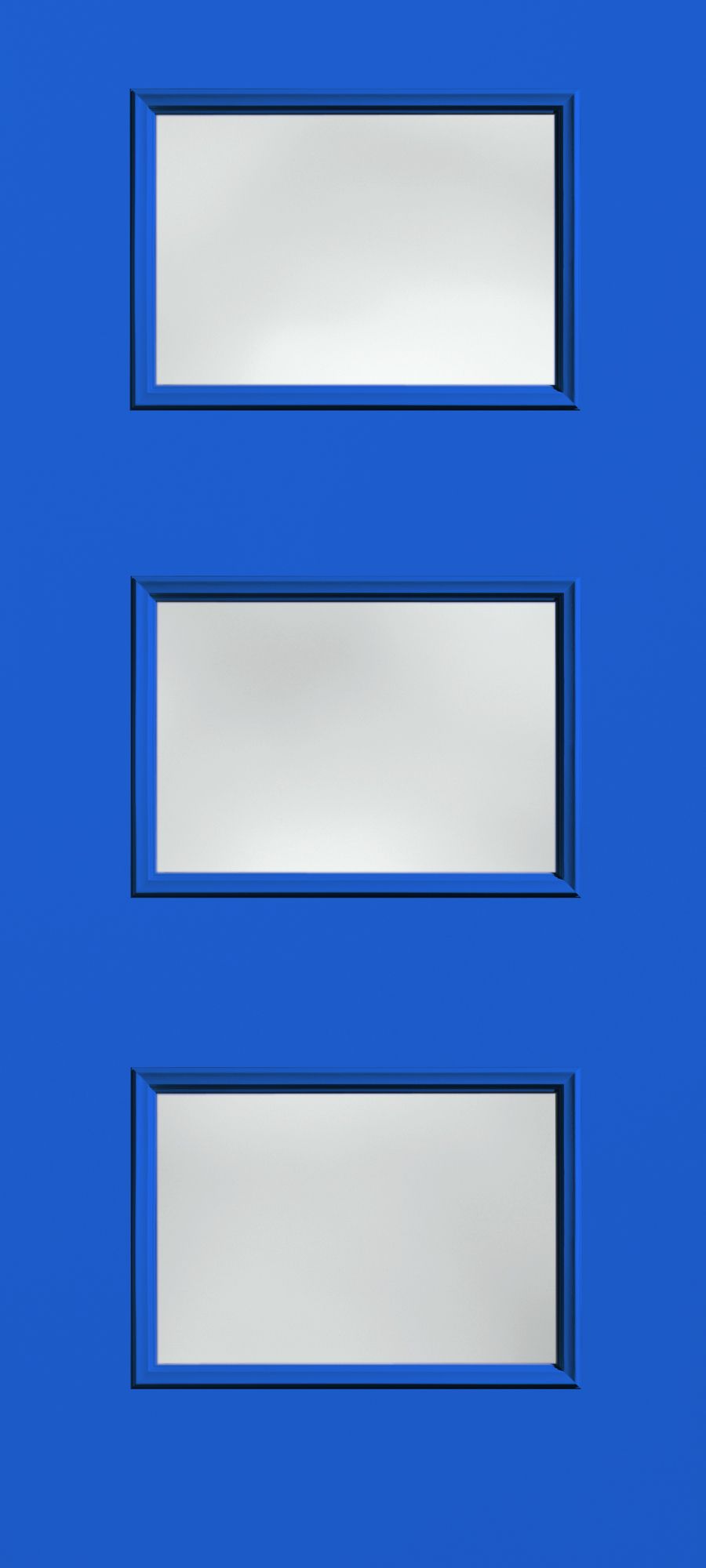
Cottage Style
Tempered glass tops a beadboard panel.
Similar to shown: Paint-ready slab; masonite.com
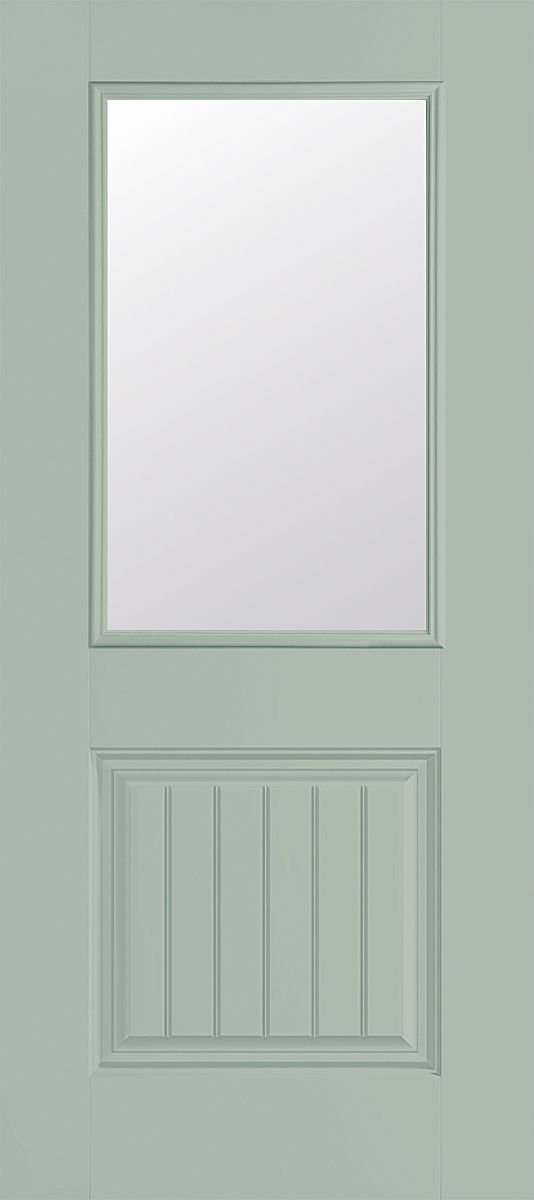
Craftsman Style
Look for recessed panels, wood-grain texture, and period details like dentil shelves or patterned and leaded lights. The grain pattern on this door draws inspiration from Mara, a South American hardwood.
Similar to shown: Feather River factory-finished door, prehung; homedepot.com
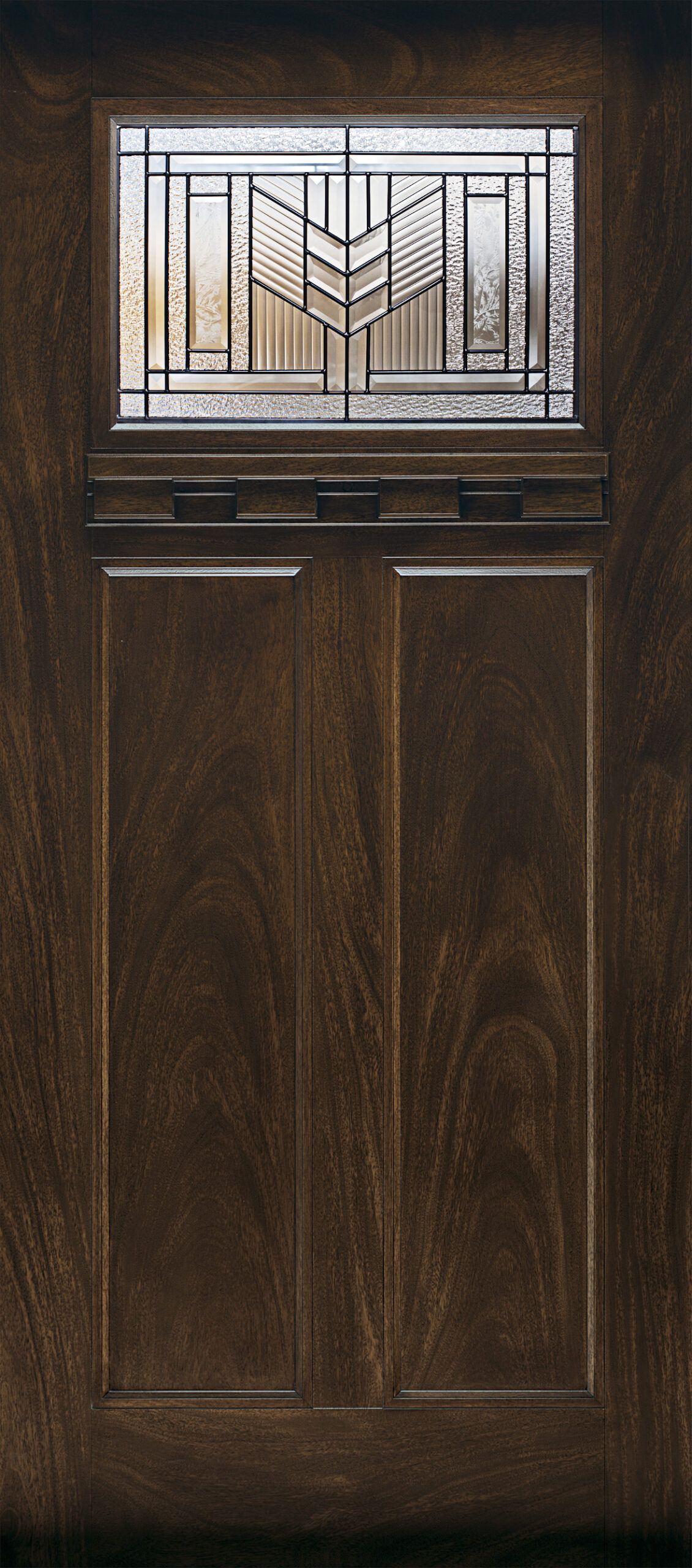
Neoclassical Style
A mahogany-like stained finish and eight molded panels lend an air of formality.
Similar to shown: Center Arch door with a factory-finish, prehung; pella.com
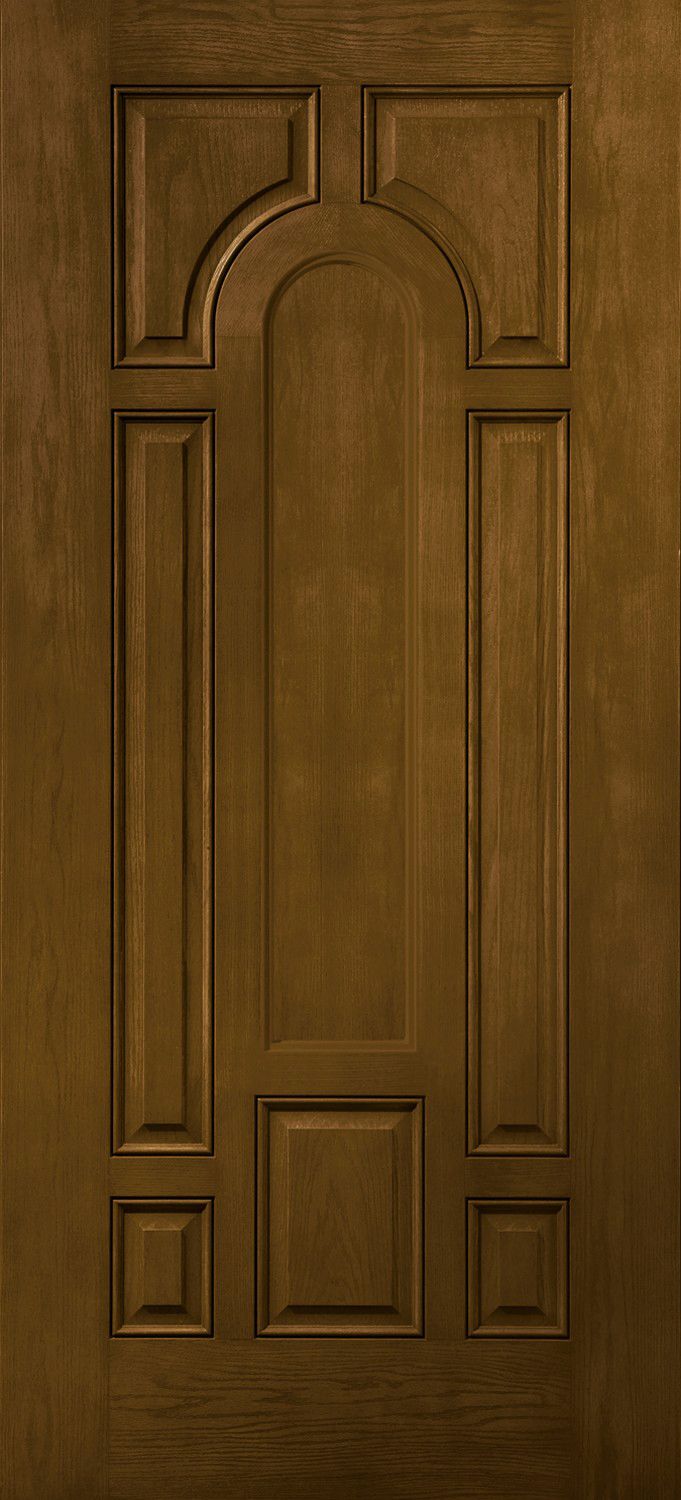
Spanish Mission Style
A dark stain, optional iron strap hinges, and a speakeasy-style window grille give this V-grooved slab its rustic appearance.
Similar to shown: 96-inch two-panel V-grooved mahogany door with speakeasy; doornmore.com
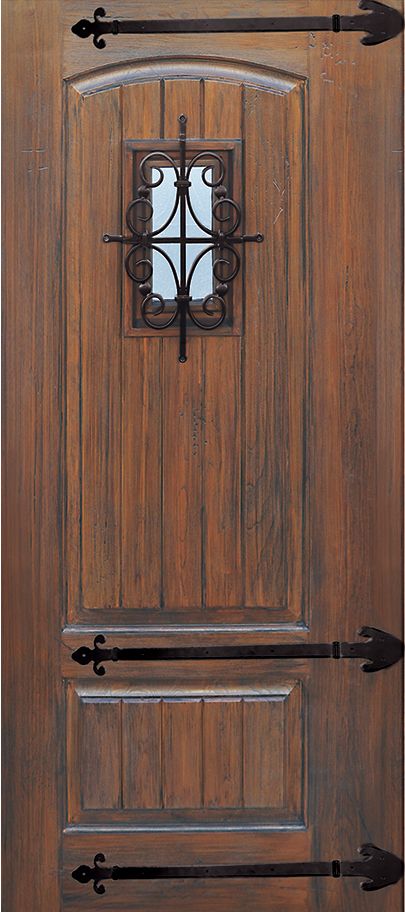
Tudor Style
This English-inspired arch-top door is also available with strap hinges and nail heads for a Southwestern look.
Similar to shown: Classic-Craft Rustic Collection door with factory-applied finish, prehung; thermatru.com
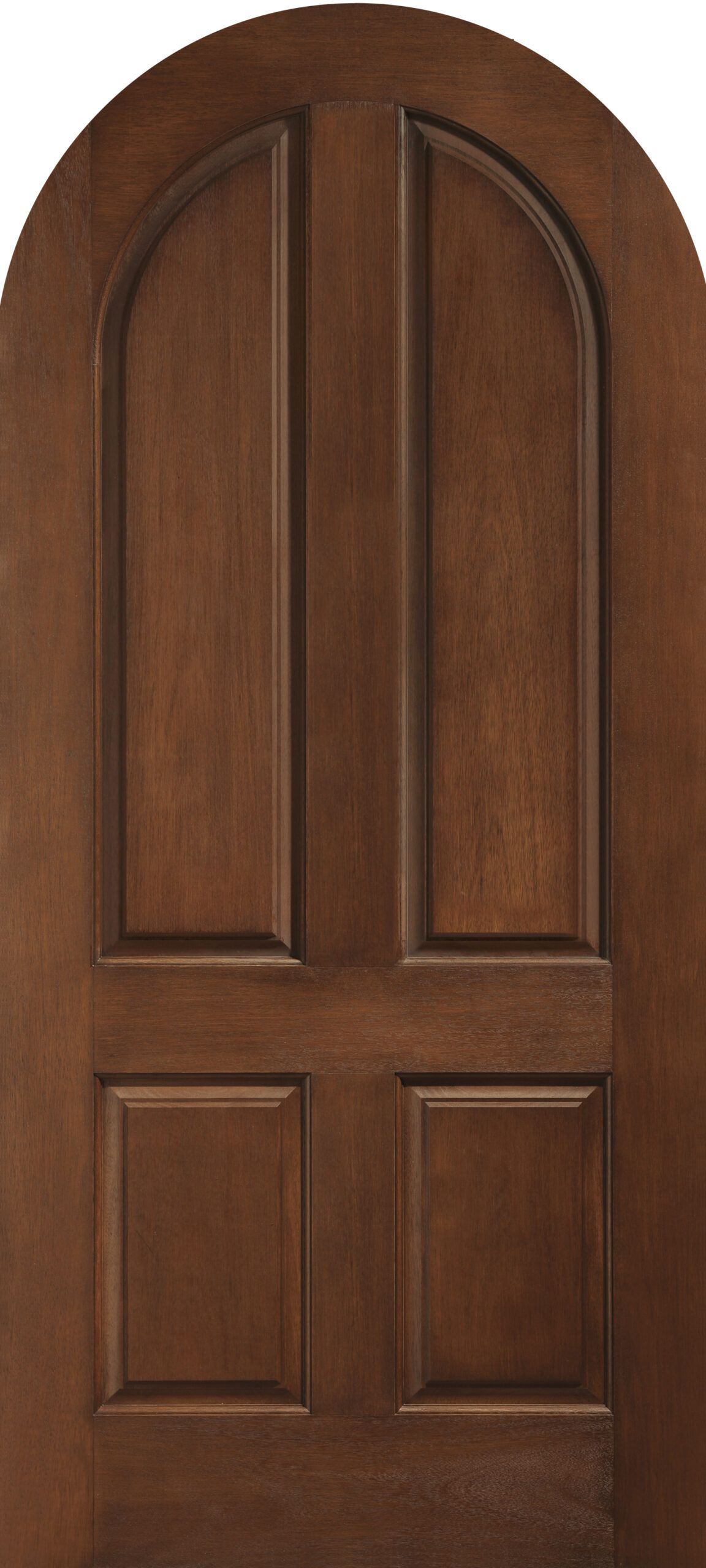
Victorian Style
A pronounced oak-grain pattern and tall arched lights give this door a late-19th-century look.
Similar to shown: Aurora Custom Fiberglass Collection Model A112 door, prehung; jeld-wen.com
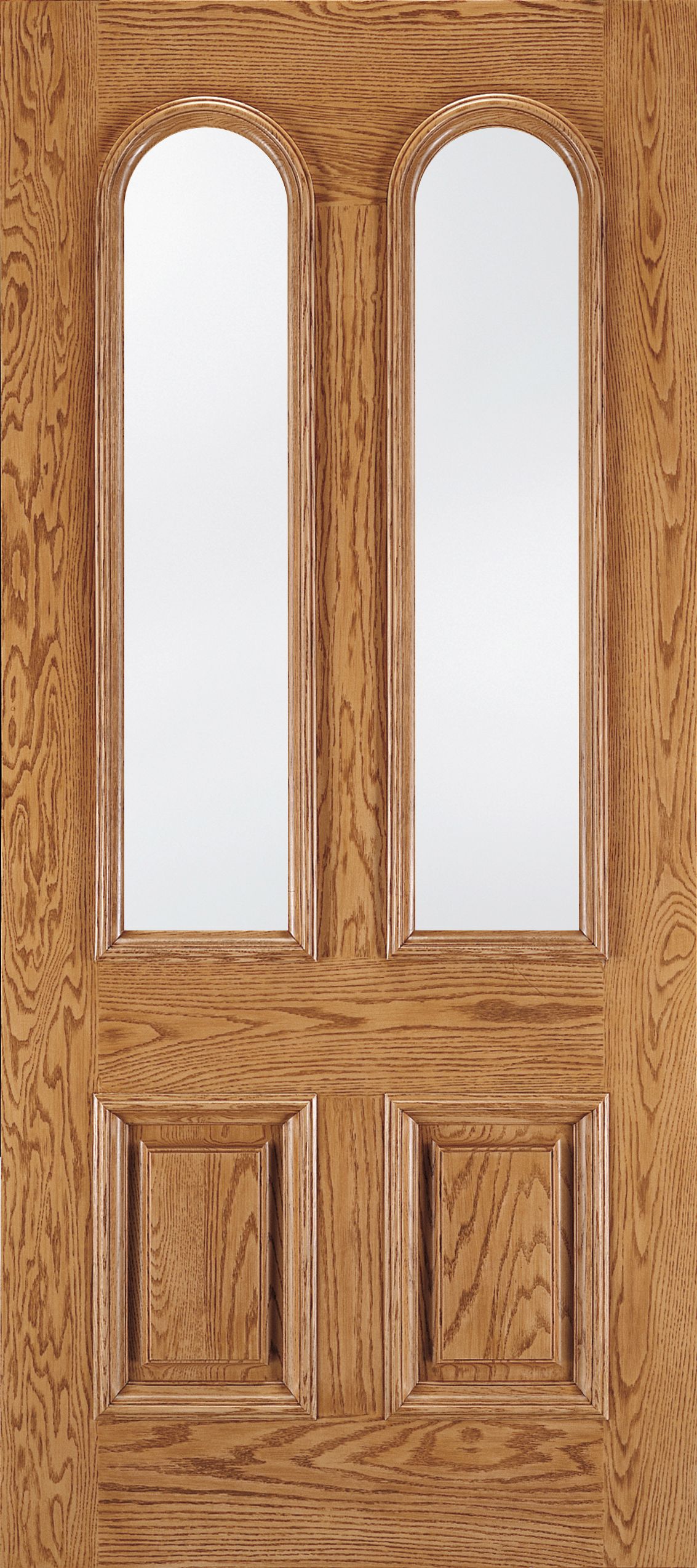
Custom Fiberglass Front Doors
There are many fiberglass door styles and designs available, but if you can’t find one that suits your home and your tastes, you might want to consider custom options like the following:
Curves Ahead
Don’t assume you’re out of luck if the door you want to replace with a fiberglass model veers from the basic rectangle.
Similar to shown: Eight-panel radius-top Model A1308 prehung door with Knotty Alder grain from the Aurora Custom Fiberglass Collection; jeld-wen.com
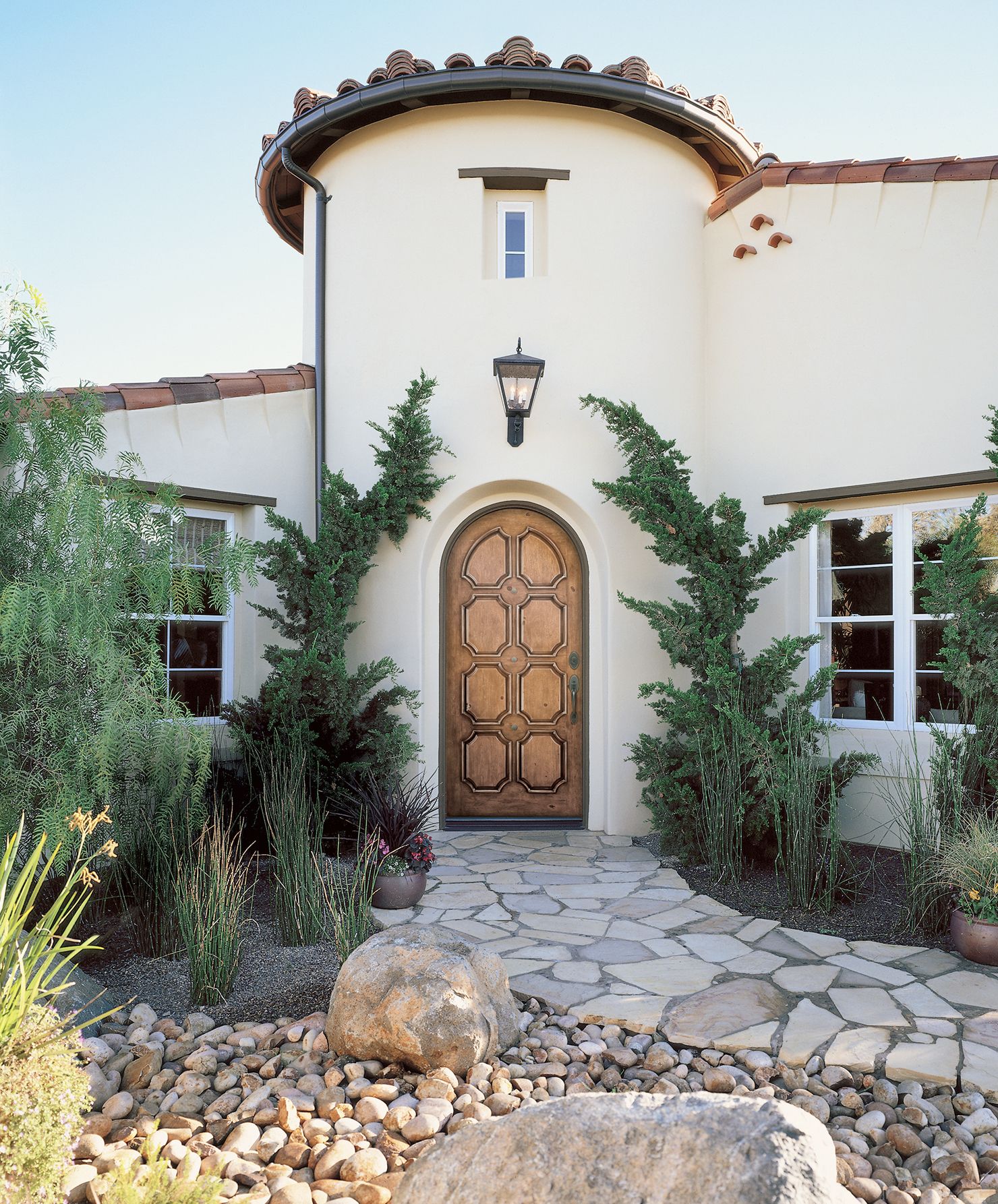
Ornamental Metalwork
Jazz up a plain entry with decorative hinges, door handles, or nail head trim. The wrought iron grille design gives this door a Garden District style.
Similar to shown: 80-inch one-panel three-fourths arch lite Charleston wrought iron alder door; doornmore.com
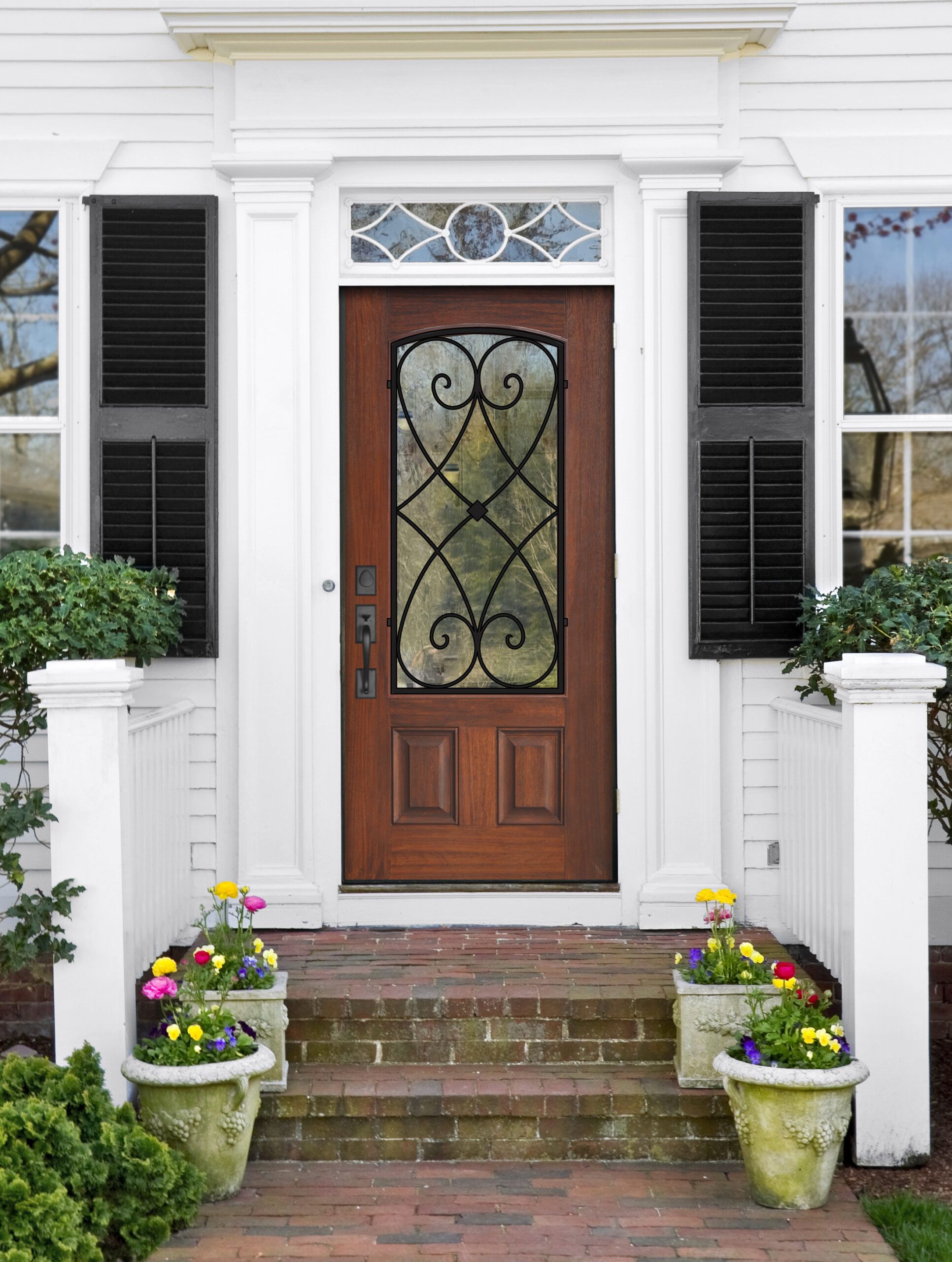
Split Doors
Many manufacturers offer the option of turning an entry door with a center rail into a Dutch door.
Similar to shown: Two-panel Model A1202 prehung door with Knotty Alder grain from the Aurora Custom Fiberglass Collection; jeld-wen.com
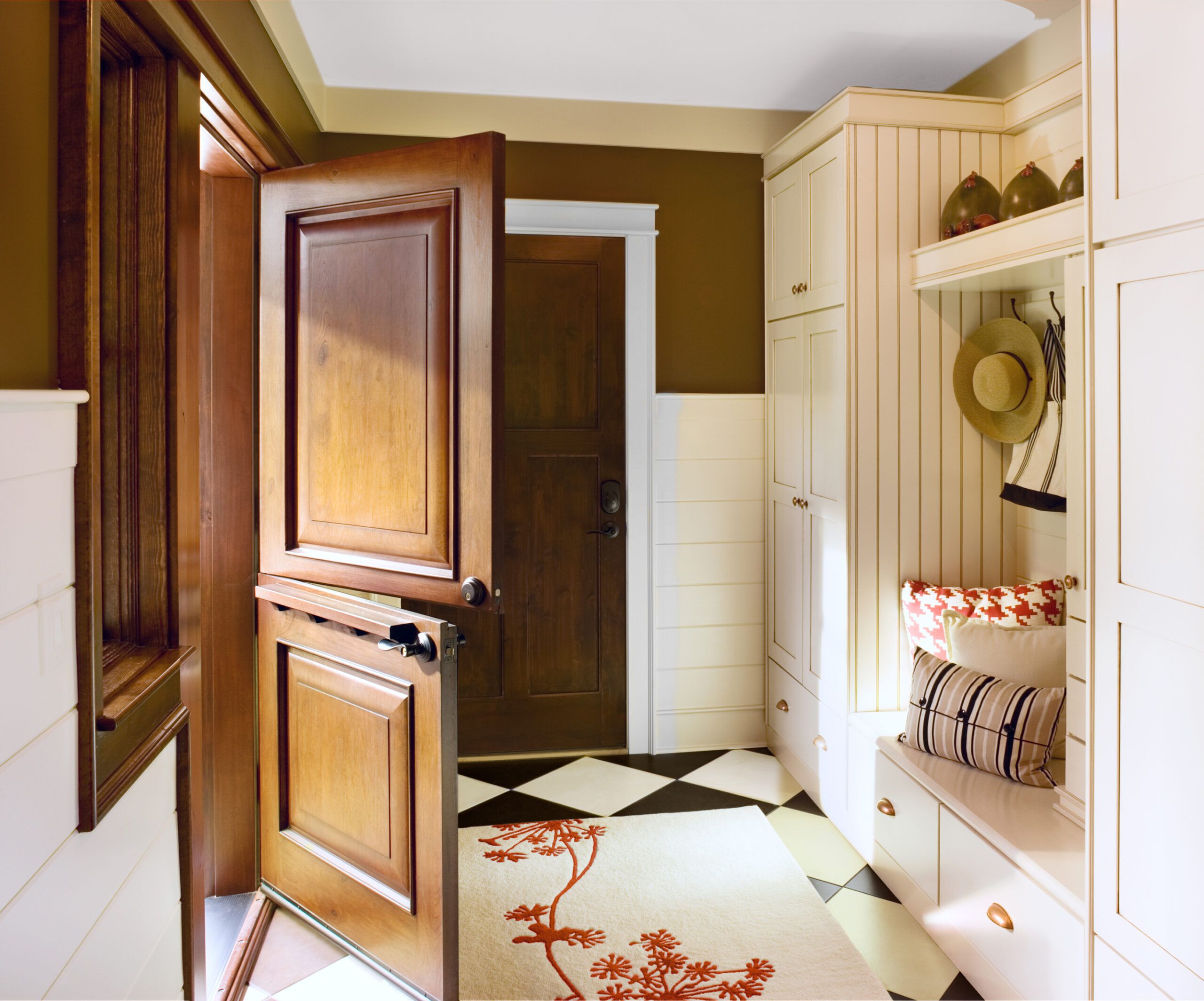
With Windows
Companies offer transoms, sidelights, and decorative glass to complement your fiberglass door.
Similar to shown: Craftsman prehung double door with Homestead windows and transom; pella.com
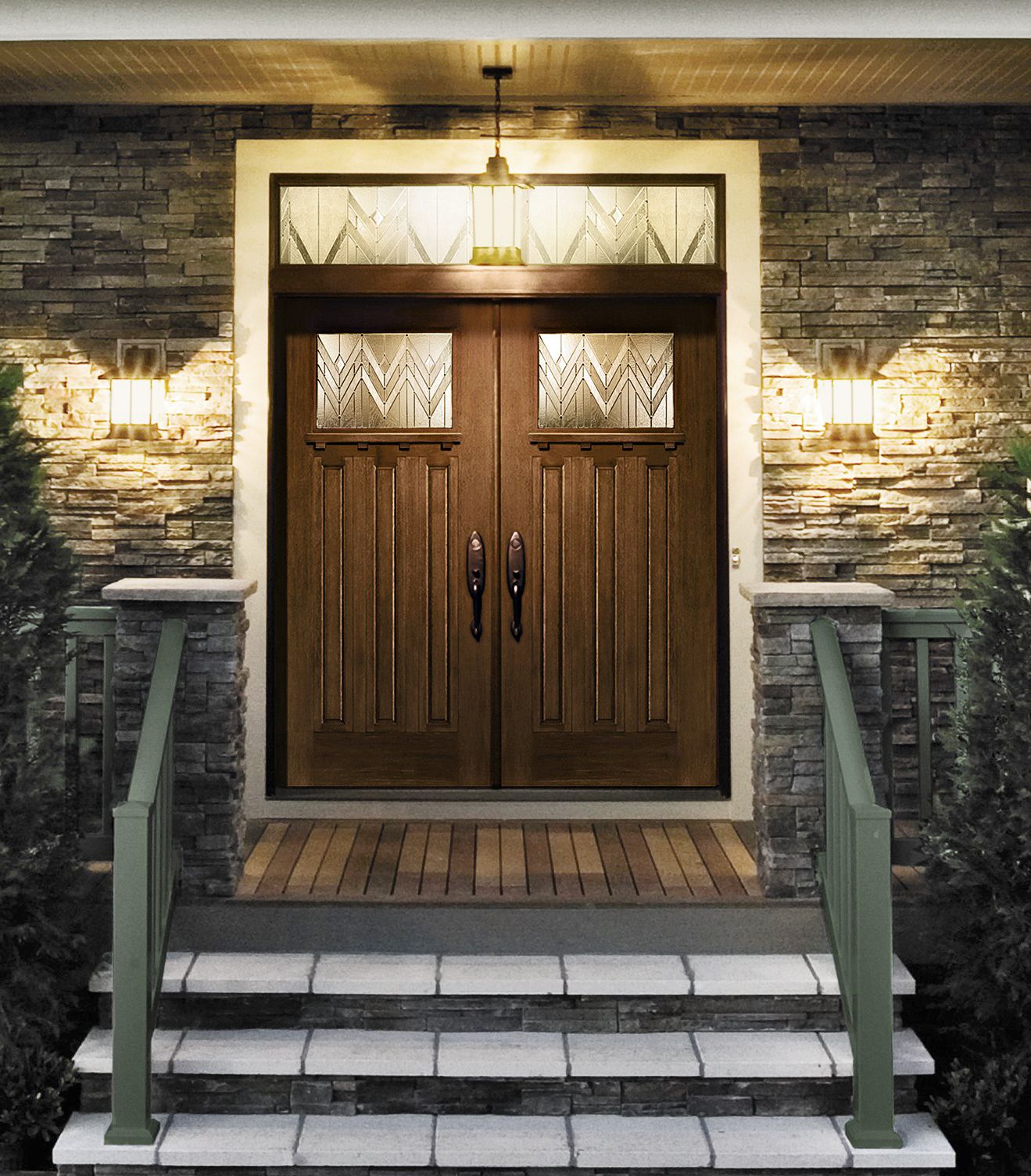
Choosing the Right Fiberglass Door
When you’re trying to choose the best fiberglass door for your home, aesthetics are only one part of the selection process. You should also account for the following factors as you shop for a fiberglass door:
Considering Climate and Exposure
Fiberglass doors can withstand the elements, but you’ll still want to make sure the door you choose is appropriate for the climate in which you live. The following factors will have an impact on your fiberglass door:
- Coastal areas: Some fiberglass doors can withstand salt air and high humidity better than others, so confirm which one is right for coastal climates if you live in one.
- Moisture: Look for models with composite stiles and rails—rather than wood—if you live in an area with high humidity or frequent rain to avoid water absorption and rot.
- Sun exposure: Find a door with a UV-resistant finish if your doorway faces direct sunlight.
Measuring for Your New Door
Your door must fit into the entryway, so take accurate measurements. You can’t trim every fiberglass door and you’ll need to check the manufacturer’s guidelines before committing to a specific model if your doorframe isn’t a standard size. Other factors to consider include the following:
- Rough opening: For a prehung unit, measure the dimensions of the rough opening in your wall. This will help determine the correct jamb width and overall door unit size.
- Wall depth: Measure the total depth of your wall to ensure you select a prehung unit with the correct jamb width.
Selecting Glass Options
If you want to incorporate a glass element in your fiberglass door, there are a few things to consider, including the following:
- Energy efficiency: Low-e glass allows light to pass through while maintaining the door’s insulating properties.
- Privacy: Doors with frosted, textured, or patterned glass will allow you to enjoy a glass window’s visual interest but still block the view.
- Safety: Tempered or laminated glass will provide more security.
Installation and Maintenance for Fiberglass Entry Doors
You can take the do-it-yourself (DIY) approach to installing your fiberglass door, but hiring a professional to install it for you has its benefits. We’ve covered the differences between professional and DIY installation below.
Professional installation offers the following benefits:
- Ensures proper fit and function
- May be required to maintain the manufacturer’s warranty
- Often includes warranty coverage
- Saves time and potential frustration
DIY installation can have the following benefits and drawbacks:
- Allows for complete control over the process
- Can save money on labor costs
- Improper installation can negatively affect door performance
- Requires specialized tools and skills
Check any potential contractor’s reviews and Better Business Bureau (BBB) rating if you hire someone to do the job for you. Hiring someone with experience installing doors will help maintain the warranty coverage and ensure they install the door correctly. If you install it yourself, follow the manufacturer’s instructions and local building codes.
Taking proper care of your door will extend its functionality and longevity. You can maintain your fiberglass door by following the suggestions below:
- Check for damage: Inspect your door for damage, such as cracks and skin separation, and address any issues immediately.
- Clean glass: Use a nonabrasive glass cleaner and follow the manufacturer’s instructions if you see any minor scratches.
- Inspect weatherstripping: Check the weatherstripping around the door for wear or damage and replace if necessary.
- Lubricate hardware: Apply a silicone-based lubricant to hinges, locks, and other moving parts annually to ensure smooth operation.
- Maintain screen doors: If you install a screen door with your fiberglass entry door, maintain it properly to prevent damage to your main door.
- Touch-up finish: If your door has a painted finish, touch up any chips or scratches promptly to prevent moisture penetration. For wood-grain finishes, apply a clear UV-protective coating every few years to prevent fading.
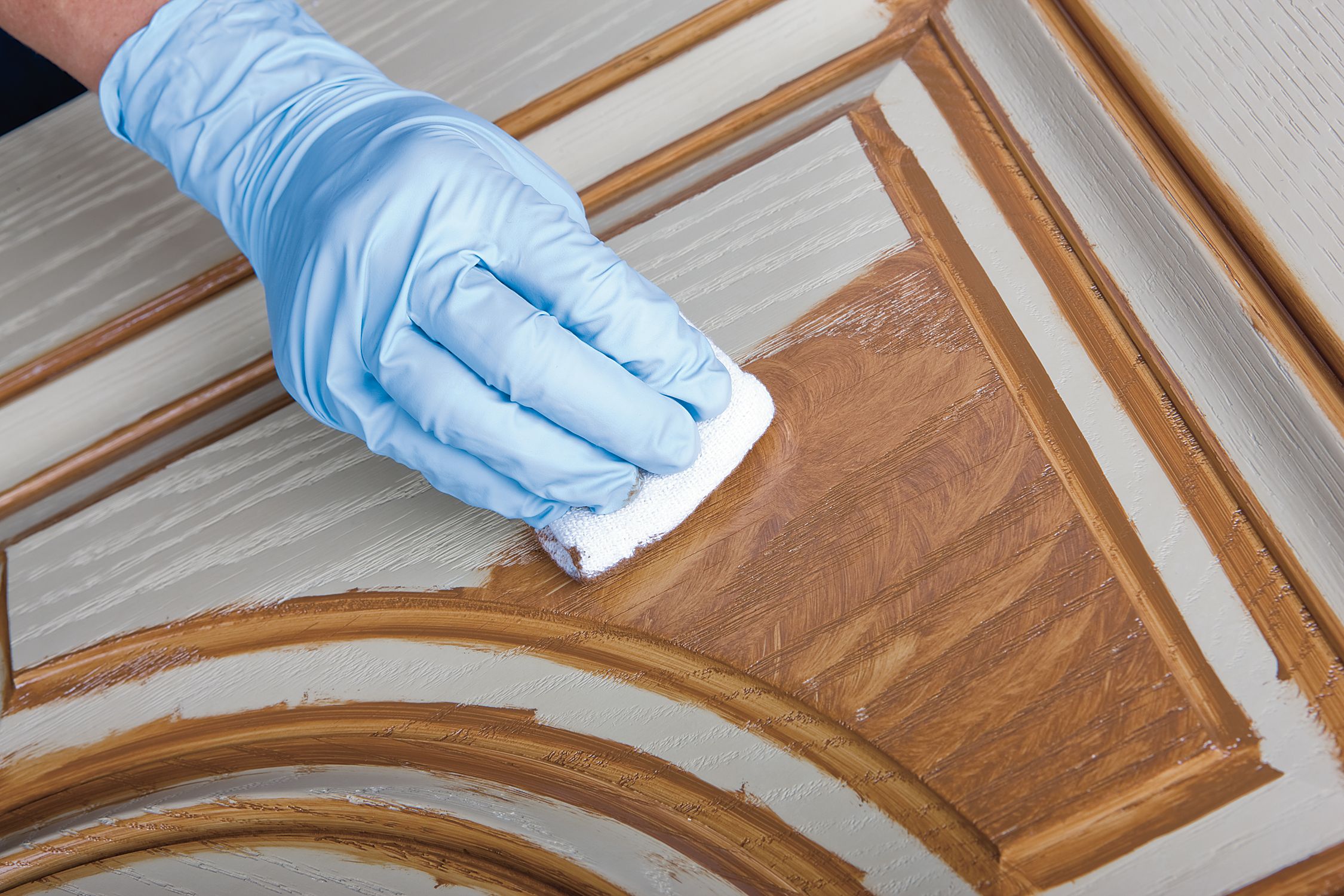
Our Conclusion
Fiberglass doors offer homeowners a durable, low-maintenance, and energy-efficient option for their front entryway. These doors come in many styles to match your exterior decor. We recommend you hire a professional to install your fiberglass door, but remember to follow the manufacturer’s instructions if you choose to install it yourself.
